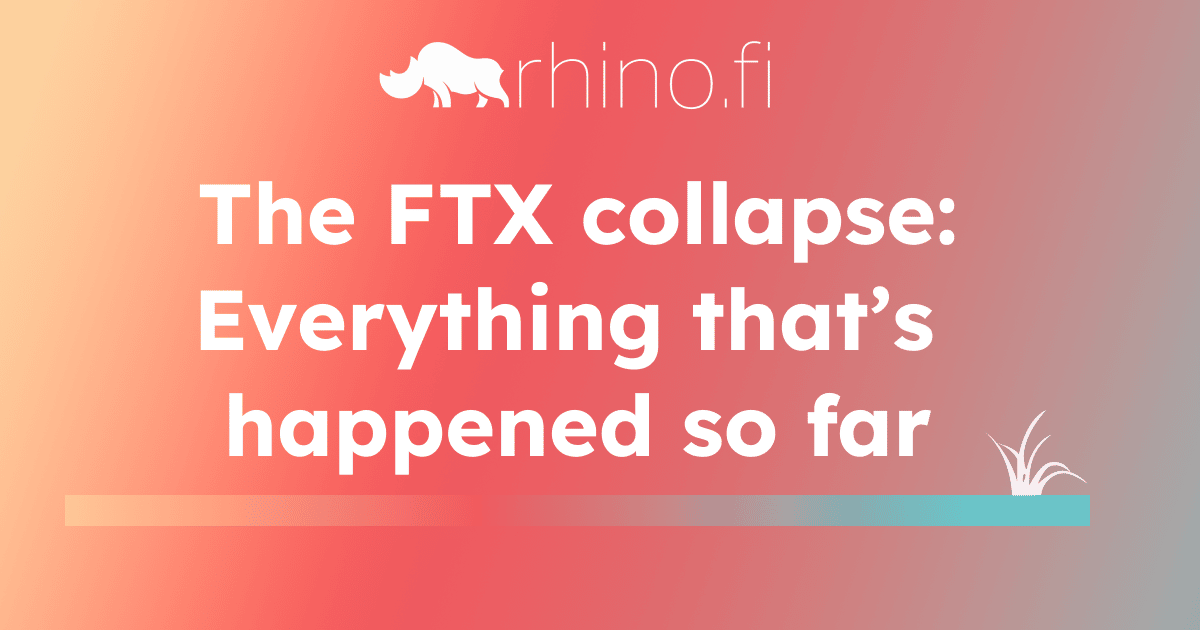The collapse of FTX is crypto’s Lehman Brothers moment. It’s a story of incendiary tweets, murky balance-sheets and glittering friendships turned to dust. Here’s how that story unfolded, day by day.
FTX is the fastest financial meltdown in history. Up to $8 billion of user funds have reportedly disappeared in a collapse which has drawn comparisons to the start of the 2008 financial crisis.
A week on from the collapse, the media frenzy is still bubbling away. The story has more twists and turns than a cultish catacomb, and most people are struggling to keep up with the thread.
In this post, we’re going to go through the crisis day by day and plot the full timeline. This is a seismic moment in crypto history (and, we hope, a ‘never-again’ moment) and you deserve the full facts about what happened.
Wednesday, November 2
Crypto news site CoinDesk publishes a report claiming that FTX’s own token, FTT, is being used to bolster the balance sheet of Alameda Research – another company founded by FTX founder Sam Brinkman-Fried (SBF). In fact, the report claims that Alameda’s holding represents 180% of the FTT in circulation.
The report gives rise to liquidity concerns, despite SBF’s attempts to dampen fears, and fuels theories that the FTX CEO was loaning customer deposits to Alameda to cover up trading losses.
Sunday, November 6 – Monday, November 7
The FTX crisis begins to accelerate when Changpeng Zhao (CZ), the head of Binance, says the exchange will be liquidating its entire FTT holding – around $530 million worth of tokens – in light of the CoinDesk report.
The news is doubly damaging because CZ and SBF have been business partners ever since Binance announced a strategic investment in FTX in 2019.
CZ’s announcement sparks a bank run: the FTX exchange sees $8bn of withdrawals in 72 hours and scrambles for liquidity.
Tuesday, November 8
Out of nowhere, CZ steps in… apparently to save the day!
CZ announces a letter of intent to acquire FTX and bail out depositors. Bitcoin jumps $1.5k on the news.
This afternoon, FTX asked for our help. There is a significant liquidity crunch. To protect users, we signed a non-binding LOI, intending to fully acquire https://t.co/BGtFlCmLXB and help cover the liquidity crunch. We will be conducting a full DD in the coming days.
— CZ 🔶 Binance (@cz_binance) November 8, 2022
At the same time, however, SBF and senior exec Caroline Ellison begin deleting old tweets assuring clients that FTX could cover all their assets.
Now deleted tweet from SBF assuring clients that FTX could fully cover client assets pic.twitter.com/4YW8hbqE7Q
— Will Clemente (@WClementeIII) November 8, 2022
Wednesday, November 9
Binance pulls out of the deal to buy FTX. In a tweet, the exchange cites due diligence failures, allegations of mishandling customer funds and alleged U.S. agency investigations. Bitcoin crashes to week-long lows of $15,500 on the news.
As a result of corporate due diligence, as well as the latest news reports regarding mishandled customer funds and alleged US agency investigations, we have decided that we will not pursue the potential acquisition of https://t.co/FQ3MIG381f.
— Binance (@binance) November 9, 2022
A leaked internal rote reveals that SBF felt CZ was never serious about the takeover.
A msg from SBF on FTX slack that got leaked to me by some telegram anon, have verified its real w another pic.twitter.com/XMjIM9nSkx
— Cobie (@cobie) November 10, 2022
Meanwhile Brian Armstrong, CEO of another exchange, Coinbase, goes public to reveal that he has also been approached to buy FTX.
However, Armstrong says he will not be going ahead with a takeover. He says the move wouldn’t make sense, but “I’m not quite at liberty to share the details right now.”
Thursday, November 10
SBF publishes his now-infamous “I f****d up” tweet, revealing that he had been lending out customer deposits to the tune of millions of dollars.
1) I'm sorry. That's the biggest thing.
— SBF (@SBF_FTX) November 10, 2022
I fucked up, and should have done better.
Elsewhere in a very suspicious move, withdrawals to Bahamian users restart as the FTX Head of Sales (Zane) cites Bahamian regulatory obligations.
1) Per our Bahamian HQ's regulation and regulators, we have begun to facilitate withdrawals of Bahamian funds. As such, you may have seen some withdrawals processed by FTX recently as we complied with the regulators.
— Zane Tackett (@tackettzane) November 10, 2022
Zane is fired 3 hours later.
Also on Thursday, the Tron Foundation provides a limited lifeline to FTX depositors, enabling existing Tron asset holders on FTX to swap Tron assets 1:1 to external wallets.
Traders rush to buy TRON on FTX at inflated prices, which limits the impact of the facility to those who already held TRON before the announcement.
BTC CEX outflows hit their highest daily peak since the liquidation of the Three Arrows Capital hedge fund in June 2022, with 53,000 BTC withdrawn (Crypto Quant).
Hester Pierce, commissioner to the U.S. Securities and Exchange Commission, says blame partially lies with her agency for not providing regulatory clarity and forcing CEXs offshore.
The fact @HesterPeirce is on Bloomberg right now, noting that this incident is partly the SEC's fault by not giving the right clarity and rules makes her my hero. 🫡
— Adam Cochran (adamscochran.eth) (@adamscochran) November 10, 2022
No other investor, politician or regulator has yet had the guts to point out the flaws in the system.
Bad ass.
Friday, November 11
FTX enters Chapter 11 proceedings.
The chapter 11 filings state an incredible $10-50bn in liabilities (likely closer to the lower end).
SBF steps down as CEO and FTX withdrawals are suspended.
Press Release pic.twitter.com/rgxq3QSBqm
— FTX (@FTX_Official) November 11, 2022
Meanwhile traders buy Bahamian know your customer-approved accounts on FTX, and the FTX NFT marketplace reaches $50m of trading volume.
Traders use the marketplace to bridge funds to KYCd accounts in order to withdraw.
Apparently this is a Bahamas account withdrawing other people's funds for them.
— Cobie (@cobie) November 11, 2022
They are likely bypassing the internal balance transfers block by selling NFTs on FTX's NFT marketplace -- eg. Bahamas account creates an NFT, the stuck user buys the NFT with their full balance. https://t.co/VphzwQprdQ
Finally… the sponsorship backlash begins with Mercedes F1, NBA’s Miami Heat and various eSports teams cancelling their FTX sponsorship deal.
In Miami, the FTX Arena sign is dismantled in record time.
13/ Mercedes F1, NBA’s Miami Heat and E-Sports teams cancel FTX sponsor deal.
— rhino.fi (previously DeversiFi) (@rhinofi) November 14, 2022
The FTX Arena sign is dismantled in record time https://t.co/tYHWPj7VMz
Saturday, November 12
The FT obtains a copy of the FTX balance sheet showing $1bn of assets against $10bn of liabilities.
It transpires that FTX reported $2.2bn worth of Serum tokens ($SRM) – even though SRM has a total market cap of only $88m.
Within hours of the FT report, the acting CEO of FTX issues a statement stating that up to $400 million of assets have been hacked. Crypto Twitter is quick to point the finger at FTX insiders.
1/ Statement from John Ray, Chief Restructuring Officer and CEO of @FTX_Official — Consistent with their obligations as Chapter 11 Debtors-in-Possession, FTX US and FTX [dot] com continue to make every effort to secure all assets, wherever located.
— Ryne Miller (@_Ryne_Miller) November 12, 2022
In the Bahamas, the country’s Securities Commission issues a statement saying that they do not advocate preferential withdrawals to Bahamian accounts.
So, any preferential withdrawals can be clawed back.
Securities Commission Addresses FTX Statement on Bahamian Withdrawals pic.twitter.com/OZKWwicSuN
— Securities Commission of The Bahamas (@SCBgov_bs) November 12, 2022
Sunday, November 13
Kraken and other exchanges freeze the exchange accounts of Alameda and FTX staff in line with law enforcement requests.
Kraken has spoken with law enforcement regarding a handful of accounts owned by the bankrupt FTX Group, Alameda Research and their executives. Those accounts have been frozen to protect their creditors.
— Kraken Exchange (@krakenfx) November 13, 2022
Other Kraken clients are not affected. Kraken maintains full reserves.
Meanwhile, the effect of the collapse begins to ripple outwards as various investors report that their money is trapped in FTX. Huboi is the latest to go public.
Finally, the Royal Bahamas Police Force announces that it is investigating potential criminal misconduct at FTX.
— Royal Bahamas Police Force (@RBPFPolice) November 13, 2022
Monday, November 13
In an attempt to curb the fall-out from FTX, Binance announces that it will form an industry recovery fund “to help projects that are otherwise strong, but in a liquidity crisis.”
To reduce further cascading negative effects of FTX, Binance is forming an industry recovery fund, to help projects who are otherwise strong, but in a liquidity crisis. More details to come soon. In the meantime, please contact Binance Labs if you think you qualify. 1/2
— CZ 🔶 Binance (@cz_binance) November 14, 2022
Tuesday, November 14
SBF announces he will soon reveal his version of what happened at FTX.
In a bizarre Twitter thread, with words broken down into a series of tweets, he says he will “all as I remember it, but my memory might be faulty in parts.”
1) What
— SBF (@SBF_FTX) November 14, 2022
Wednesday, November 15
SBF speaks!
In another (slightly less baffling) tweet thread spread over several hours, Brinkman-Fried says he:
- Sincerely apologises for what happened.
- Will meet regulators in person.
- Is committed to sourcing new liquidity and making customers whole.
- Will support “radical transparency” if FTX continues to operate.
SBF also says FTX was over-leveraged when Binance pulled out, but claims Alameda had more assets than liabilities at the time.
11) I'll get to what happened. But for now, let's talk about where we are today.
— SBF (@SBF_FTX) November 15, 2022
Thursday, October 17
Acquisition deal collapses
Canadian crypto exchange Bitvo has terminated its expected acquisition of FTX, per Coinbase (which kicked off the whole FTX scandal by revealing balance sheet details of sister company Alameda Research).
Bitvo insists the decision has nothing to do with FTX’s bankruptcy filing, and says it has no exposure to FTX or any related entities.
Elsewhere, Singaporean investor Temasek has written off a $275m in FTX, saying its trust in SBF (exchange founder Sam Brinkman-Fried) was “misplaced.”
And details of a class-action lawsuit against FTX have begun to emerge, with NFL star Tom Brady and Seinfeld creator Larry David among those named (David, a comedian known for his sardonic style, appeared in an commercial for FTX titled ‘Don’t be like Larry’, arguably the most recognisable crypto ad ever aired).
Friday, November 18
New CEO condemns ‘complete failure of corporate controls.’
Full details of FTX’s bankruptcy filing to the District Court of Delaware have been made public.
In the filing, new CEO John J Ray, who has taken over from Sam Brinkman-Fried (SFB), says:
‘Never in my career have I seen such a complete failure of corporate controls and such a complete absence of trustworthy financial information as occurred here.’
The statement also reveals that FTX’s true liabilities are not reflected by the financial statements prepared during SBF’s time at the help, and that sister company, Alameda Research – which apparently received $10 million of FTX deposits – did not complete proper books and records.
Saturday, November 19 – Monday, November 21
FTX owes over $3 billion; Vitalik blames people, not technology.
The fallout from the FTX collapse has continued apace over the weekend, as it emerged that the bankrupt exchange owes nearly $3.1 billion to its 50 biggest creditors.
According to the latest court filings, the largest creditor is owed $226 million and the top 10 creditors are owed $1.45 billion.
Meanwhile Vitalik Buterin, the co-founder of Ethereum, has offered his own appraisal of the FTX downfall – and suggested the technology is not to blame.
In fact, Vitalik told Bloomberg that the collapse was down to people, referring to the actions of senior executives such as FTX founder Sam Bankman-Fried.
Referring to the future of crypto and DeFi, Vitalik also said that many in the Ethereum community believe that “centralized anything is by default suspect” and the FTX collapse has only reaffirmed this.
Tuesday, November 22
FTX was ‘run as personal fiefdom’, court hears
A U.S. bankruptcy court has heard damning testimony about life at FTX.
At the court in the U.S. state of Delaware, attorney James Bromley, leading the bankruptcy proceedings, said the collapsed exchange was ‘run as a personal fiefdom of Sam Bankman-Fried [the founder of FTX, also known as SBF].’
Bromley also said the exchange lacked basic money controls and senior executives used company funds to spend millions of dollars on property.
In fact, official property records seen by Bloomberg suggest that parents and colleagues of SBF bought at least 19 properties worth $121 million.
Wednesday, November 23
SBF apologises
In a letter to colleagues, first reported by Coinbase, Bankman-Fried said he ‘deeply regrets’ his failure to maintain proper oversight of FTX, but claimed the business could have been saved had he not been pressured to declare bankruptcy papers.
‘Potential interest in billions of dollars of funding came in roughly eight minutes after I signed the chapter 11 docs. Between those funds, the billions of dollars of collateral the company still held, and the interest we’d received from other parties, I think that we probably could have returned large value to customers and saved the business.’
We’ll continue to update this thread with FTX news as and when new information emerges. And we’ll also be publishing advice pieces advising you how to move funds over from CEXs to rhino.fi, so you can enjoy all the protection of a DEX./////////////////




